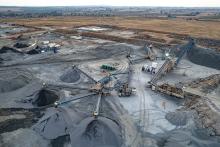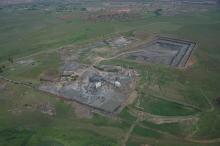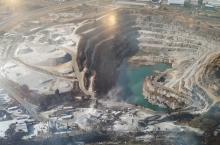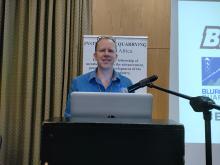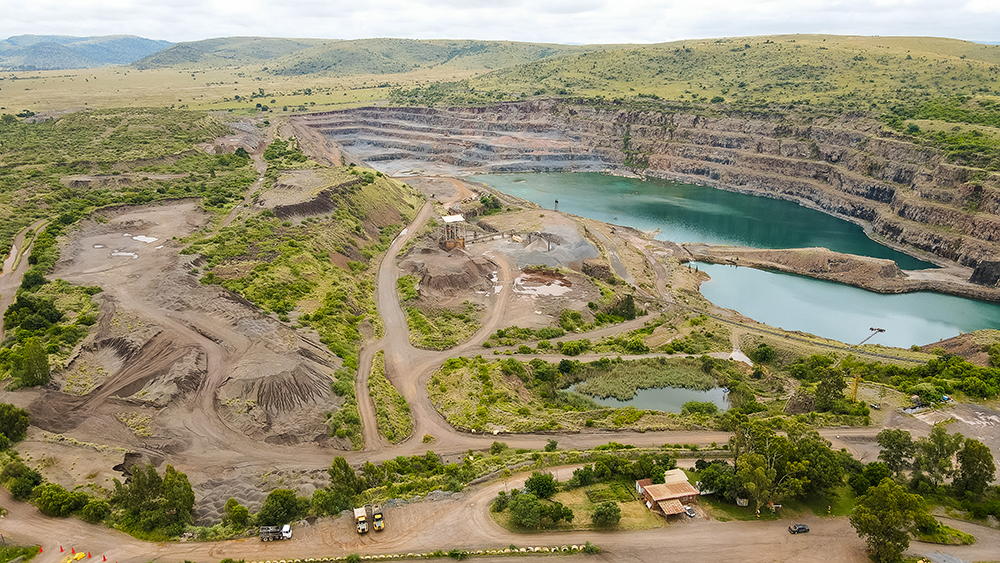
Since 2017, the South African construction sector has seen a steady decline in volumes, with the Covid-19 outbreak in 2020 providing a devastating blow to an already ailing industry. That many quarries in the country are in dire straits is no overstatement. In the face of it all, business is still firing on all cylinders at PPC’s Mooiplaas Dolomite Quarry, despite a dip in overall volumes, especially on the aggregates side of things.
The quarry’s key competitive edge is its homogeneous dolomitic reserve, one of three of this type in the Gauteng Province. Apart from the traditional aggregates market, the dolomitic nature of the rock allows the quarry to supply three other industries, namely the steel industry (metallurgical dolomite), the chemical industry (metallurgical dolomite powder to fertiliser manufacturers) and the agricultural sector (agricultural lime).

“Most of the products we manufacture add real value to our customers’ businesses. For example, due to the cementitious properties of dolomite, many readymix concrete producers prefer our super sand because it helps them reduce both cement and water content in their mixes,” explains Arthur Ndindani, general manager PPC Aggregate Quarries.
Apart from super sand, Mooiplaas also produces a unique -2mm product, a very fine type of sand mostly used for finishing in the production of paving bricks. Even the general aggregate products from Mooiplaas, such as 19mm, 13mm, 9.5mm, 6.7mm and washed crusher sand are much sought after because of the cementitious values of the rock. This is further complemented by the fact that the quarry washes all its products to improve quality.
Aggregate, by its nature, is a high-volume, low-margin material and usually cannot be transported over 80km from a cost perspective. However, because of the high-quality nature of the product, Mooiplaas supplies its aggregates to areas as far as Polokwane, Limpopo (about 300km) and Nelspruit, Mpumalanga (about 350km), according to Shadrack Molawa, Works Manager at Mooiplaas. The metallurgical lime produced here is of very high quality and is supplied to areas as far as the Eastern Cape, which is over 600km away.
The quarry’s footprint in the agricultural sector also worked to its advantage during the Covid-19 influenced hard lockdown in 2020. When all other operations had to close shop, Mooiplaas was considered an ‘essential service’ operation because it had to continue supplying agricultural lime to the farming community. This placed the business in good stead to survive the pandemic better than traditional aggregates quarries.
It was during the Covid-19 lockdown that the management team at this operation also had to rethink its business, resulting in a number of efficiency improvements that have had a vast impact on the overall business to date.
“The year 2020 was undoubtedly one of the most difficult in recent memory. It, however, compelled us to find new ways of improving our business in an uncertain environment. In order to tackle this reality, we all agreed that our post-lockdown success lied in efficiency,” explains Ndindani. “We identified some problem areas in our processes and the mining area was our first point of focus. We also realised that improvements in the pit would have a big ripple effect in downstream processes.”

Firstly, the team looked at all the factors that affected the tonnes per hour (tph). One of the problem areas identified was the long cycle times, largely due to the long hauling distances from the quarry face to the primary crusher. Consequently, a decision was taken to redesign the quarry to shorten the hauling distances.
“As part of this process, we also redesigned our haul roads. The hauling distances from the face to the primary tipping point have become shorter, thus improving our cycle times significantly. Previously, we were achieving between seven-and-a-half and eight-minute cycles times, but we have now cut that down to about five minutes. Consequently, our tonnes per hour have jumped from around 550 to 620tph. We also saw a huge decline in our fuel burn, which reduces our costs significantly, given the soaring prices of diesel,” explains Molawa.
As part of the mine redesign (with the help from the group’s mining team) the mining direction was changed. Traditionally, the team had always mined towards the western side. Because of inherent safety issues, the previous mining team put less focus on the northbound section. “We had to redesign the mine to allow us to tap into the northward deposit. After the redesign we actually realised that the deposit is outcropping as you move to the north, reducing the amount of overburden we had to strip. By changing the mine design, we have managed to reduce our stripping ratio from the previous 25% to 16%,” explains Ndindani.
Evaluation of blast efficiency in quarrying, stresses Ndindani, is one of the most important decisions that should be made by quarry operators for productivity assessment. Based on this understanding, the Mooiplaas team reviewed its blasting practices to improve fragmentation. This has also improved other downstream operations such as load and haul as well as crushing and screening.
As part of the new blasting regime, Mooiplaas adopted electronic blasting, moving away from traditional shock-tube technology. The quarry was one of the first operations to adopt BME’s latest-generation AXXIS Titanium electronic detonation system. Having been involved in the testing phase of this product well before its commercial rollout last year, the Mooiplaas team experienced first-hand the efficiency benefits of electronic blasting, which outweighed the initial higher capital outlay.
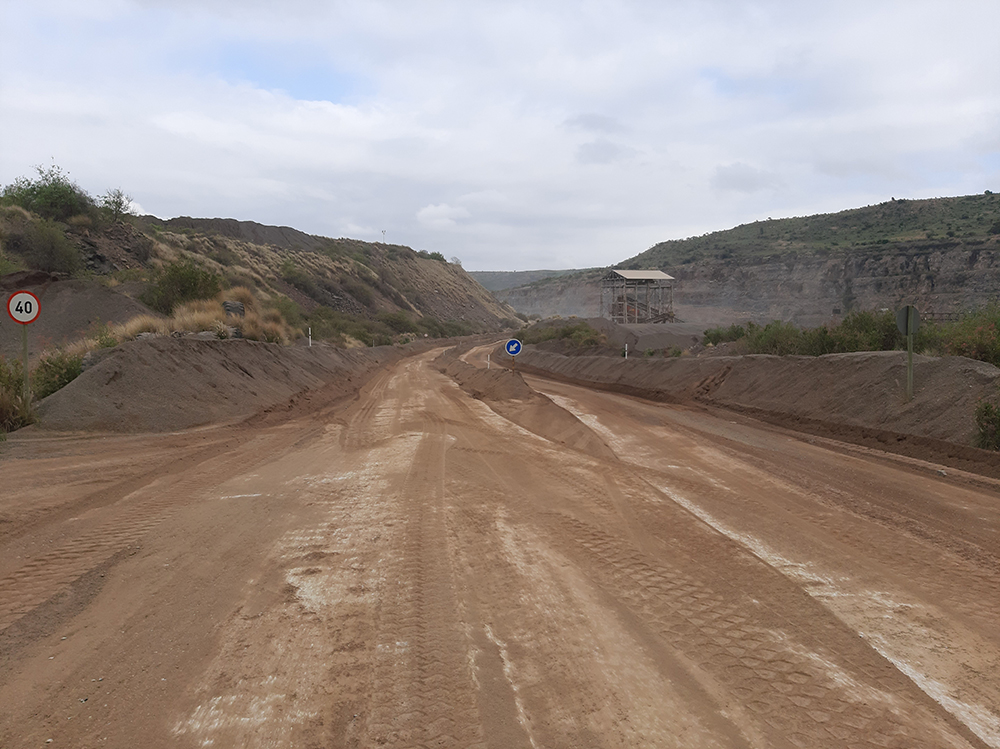
“With electronic detonation, we have managed to improve our blast outcomes, mining efficiencies, environmental impact control and safety. Because of better fragmentation capabilities of this technology, we have managed to increase our burden and spacing, which reduces our powder factor and total metres drilled, thus cutting costs related to drilling and blasting,” says Molawa.
Although Mooiplaas is blessed with a soft rock, the geology traditionally dictated for close burden and spacing using the previous shock-tube technology. This is because within the dolomite itself, there are pockets of soil fissures. If not managed properly, the blasts end up with big boulders which require secondary blasting or further mechanical breaking. Secondary blasting or breaking of oversize material costs money, and a lot of it. Industry statistics show that it could be as much as four times the cost of the initial blast. With electronic blasting, the soil pockets are easily intercepted without the need to close the burden and spacing, which reduces the overall cost of blasting.
Working closely with suppliers has been another success factor for Mooiplaas. A significant portion of the processes at Mooiplaas are outsourced to contractors. Drilling is outsourced to Bustque, which has been on site for many years, while load and haul is done by Alpha Plant Hire. Outsourcing these processes is aimed at a combination of downsizing the company’s fixed costs and reducing capital investments.
“We work closely with our contractors, and they have been part of our optimisation process. They understand what we are trying to achieve. Consultation was a big process of our efficiency-improvement programme. For example, we had to demonstrate to the drilling contractor that reducing burden and spacing didn’t necessarily translate into reduced metres drilled. The more efficient we are in all our processes, the more we deplete our run of quarry material on the ground, which increases our drill and blast frequency, thus translating into more business for the drilling contractor,” explains Ndindani.
“On the load and haul side of things, we have brought in a new contractor, Alpha Plant Hire. They have a big focus on efficiency, which speaks to what we are trying to achieve at Mooiplaas. We also involved them in the optimisation process from the start, and they fully understand our goals,” adds Ndindani. “A close working relationship with blasting technology supplier, BME, has also translated into massive efficiency gains. Their guidance has helped us realise the massive gains associated with electronic blasting.”
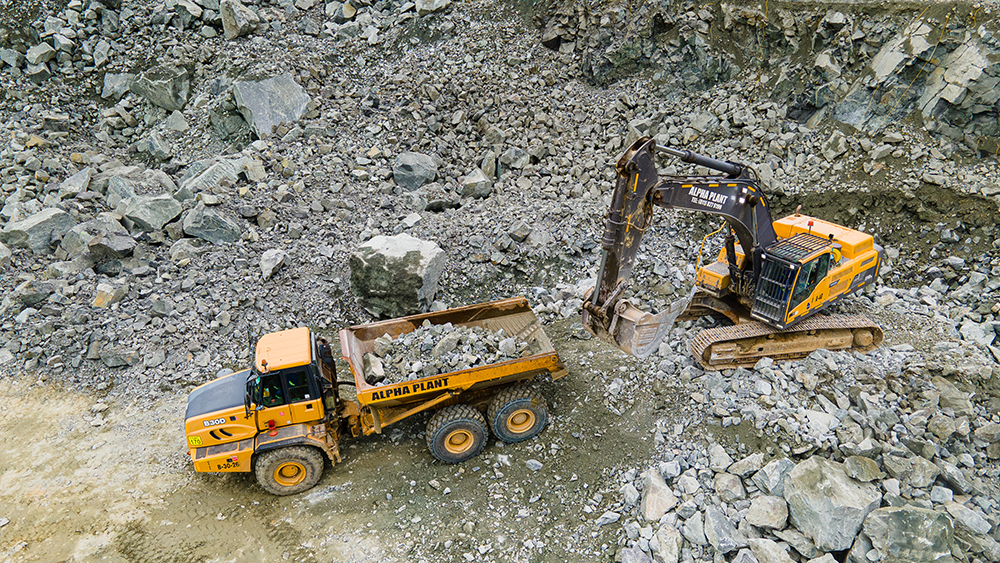
Blasts are kept large to meet the high demand of material from the various markets. The quarry blasts about 150,000t of material on the ground every month, with 100,000t destined for the aggregate market and the remaining 60,000t to the dolomite market. A chemical analysis is conducted on the material inside the company’s laboratories. Anything with a silica content of below 2.5% is classified as metallurgical dolomite, and anything above that is considered aggregate material.
To further grow its market reach, PPC has broadened its footprint by catering for the informal market. “During the hard lockdown in 2020, one of our resolutions was to approach the informal market. With all the developments happening in the townships, we targeted township brickmakers. The majority of them were not aware that they could buy material directly from us. Because of the cementitious properties in our sand, they have seen massive cost reductions in their brickmaking processes,” explains Ndindani.
PPC’s strategy also entails ‘keeping everything at home’. There are two divisions within the company, namely PPC Cement and PPC Materials Division, which consists of PPC Ash, PPC Readymix and PPC Aggregates. The Readymix business is a major volume driver for the other three divisions – Cement, Ash and Aggregates. While the quarry supplies to various other external customers, PPC Readymix is the largest customer in terms of aggregates. PPC is one of the largest readymix suppliers in the country, with a national footprint of 32 sites. To meet the high demand of its products, PPC runs a 24/7 operation at Mooiplaas.

